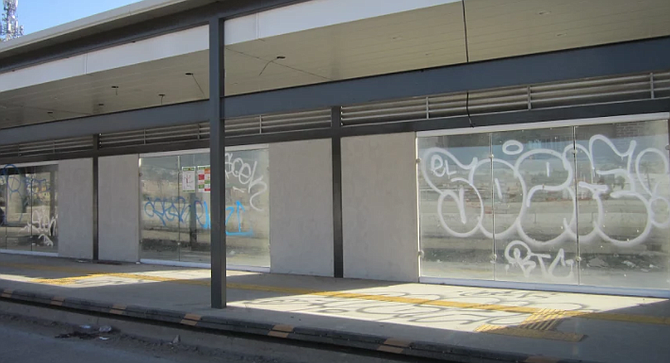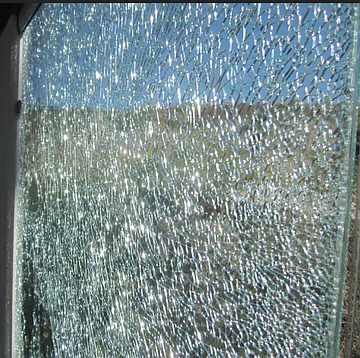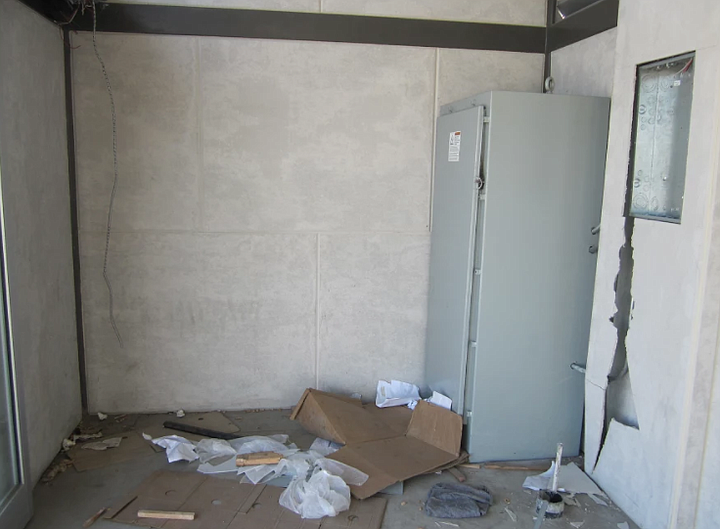 Facebook
Facebook
 X
X
 Instagram
Instagram
 TikTok
TikTok
 Youtube
Youtube

Shattered glass. Sandstone rocks. Soiled clothing. Human feces. Exposed electrical cables hanging from ceilings. Trash strewn along the floor. These are generally not the things one imagines when newly built ‘modern transportation’ comes to mind. But, for parts of Tijuana, this has become the reality. The future of the city’s Sistema Integral de Transporte de Tijuana, or SITT (pronounced seat), is uncertain thanks to the political self-interest at play.

The new public bus system - which cost federal and state government, as well as international investors, about $60 million to construct - was designed to transform public transit with air-conditioned buses, a smart-card payment system, security cameras, and Wi-Fi. Estimates posited it would serve 120,000 passengers per day.

While Centro’s (downtown Tijuana’s) bus stations appear in good condition, a ten-mile jaunt from the San Ysidro border crossing along Via Rapida (the city’s main north-south highway) towards Colonia Insurgentes, in the Tijuana’s southeast, tells a different story about the bus system. Bus stations, decorated by taggers, are in decay - at least one seemingly with a bullet hole in its shattered glass. On social media, locals have suggested the bus stops should be used for community centers, live theater, and live music.

"Broken glass, cable theft, fiber optic theft, theft of the ducts for the electrical system, and graffiti,” the system’s general secretary Arturo Aguirre listed the damages at a recent city council meeting.
Some of the stations act as ovens to bake the human feces inside. One sullied station has yellow concrete barriers closing it off entirely from all traffic, including buses. While public buses run along Via Rapida, most of the stations never opened or are currently out of service. Some appear to be half-built, though much of the glass has simply been broken and anything of value on the inside stripped.
According to El Sol de Tijuana, fifteen bus stations (47 were built in toto) have been vandalized with four “seriously affected.” Officials estimate the damages already exceed more than one million pesos. While most of the funds for the system came from state and federal government, the municipal government must maintain the stations and repair the damages.
SITT representatives cites the lack of security at the stations for the desecration. "The stations are being vandalized and every day that passes they deteriorate further. They are practically losses for the city council," said the General Secretariat of Government, who noted that from November to December 2016 private security was contracted for 18,000 pesos per week.
Previous mayor Jorge Astiazarán, from the Institutional Revolutionary Party (PRI), had even assigned municipal police to protect the stations. But the current mayor as of November 30, 2016, National Action Party’s (PAN) Juan Manuel Gastélum, received support from the city’s transit businesses, known collectively as transportistas or la mafia transportistas. He withdrew security for the stations.
"The problems that we have today could have been avoided,” the General Secretary of the government explained. “It is very easy to break the glass [at night], because the stations are unmanned...”
He added: "To hurt a station is to hurt our heritage as citizens.”
Those who believed the current administration’s perceived alliance with the established transportation industry would stall the city-wide planned modern busing system were correct. Critics cite the damages to the many stations as evidence of the new administration’s lack of interest in SITT, which was originally announced to the public in September 2015.
In an opinion piece appearing in Uniradio early this month, the paper asks: “How long until the government offers a quality service?”
As well: “How long until they repair the stations? And how long until they punish the crooks who destroy the city?”
Aguirre notes that the city is taking care of the stations that are being used by passengers.
Buses and riders have also been targeted. Late last month, in Colonia El Niño to the city’s east, a group of at least ten men armed with bats, sticks and stones forced passengers off a bus and damaged it.
“They have vandalized six vehicles,” Aguirre said at the time, who noted some passengers have been shoved off busses. It does not appear, however, as if the passengers were robbed. The vandals told the passengers to leave or suffer the consequences.
Public bus officials, who claimed to know that private transportation provider ‘Altisa’ was responsible for the damages, said they would not remain apathetic, demanding that the director of transportation, Javier Salas, “se ponga las pilas”. (translation: ‘get with it’)
In Centro and Zona Norte, however, SITT seems to be the modern bus system promised by the previous administration. On a Sunday, I saw the Centro bus station - in pristine condition - filled with about 15 people. Just north, a bus picked up riders at the system’s Zona Norte two-story main station along Avenida Revolución.


Shattered glass. Sandstone rocks. Soiled clothing. Human feces. Exposed electrical cables hanging from ceilings. Trash strewn along the floor. These are generally not the things one imagines when newly built ‘modern transportation’ comes to mind. But, for parts of Tijuana, this has become the reality. The future of the city’s Sistema Integral de Transporte de Tijuana, or SITT (pronounced seat), is uncertain thanks to the political self-interest at play.

The new public bus system - which cost federal and state government, as well as international investors, about $60 million to construct - was designed to transform public transit with air-conditioned buses, a smart-card payment system, security cameras, and Wi-Fi. Estimates posited it would serve 120,000 passengers per day.

While Centro’s (downtown Tijuana’s) bus stations appear in good condition, a ten-mile jaunt from the San Ysidro border crossing along Via Rapida (the city’s main north-south highway) towards Colonia Insurgentes, in the Tijuana’s southeast, tells a different story about the bus system. Bus stations, decorated by taggers, are in decay - at least one seemingly with a bullet hole in its shattered glass. On social media, locals have suggested the bus stops should be used for community centers, live theater, and live music.

"Broken glass, cable theft, fiber optic theft, theft of the ducts for the electrical system, and graffiti,” the system’s general secretary Arturo Aguirre listed the damages at a recent city council meeting.
Some of the stations act as ovens to bake the human feces inside. One sullied station has yellow concrete barriers closing it off entirely from all traffic, including buses. While public buses run along Via Rapida, most of the stations never opened or are currently out of service. Some appear to be half-built, though much of the glass has simply been broken and anything of value on the inside stripped.
According to El Sol de Tijuana, fifteen bus stations (47 were built in toto) have been vandalized with four “seriously affected.” Officials estimate the damages already exceed more than one million pesos. While most of the funds for the system came from state and federal government, the municipal government must maintain the stations and repair the damages.
SITT representatives cites the lack of security at the stations for the desecration. "The stations are being vandalized and every day that passes they deteriorate further. They are practically losses for the city council," said the General Secretariat of Government, who noted that from November to December 2016 private security was contracted for 18,000 pesos per week.
Previous mayor Jorge Astiazarán, from the Institutional Revolutionary Party (PRI), had even assigned municipal police to protect the stations. But the current mayor as of November 30, 2016, National Action Party’s (PAN) Juan Manuel Gastélum, received support from the city’s transit businesses, known collectively as transportistas or la mafia transportistas. He withdrew security for the stations.
"The problems that we have today could have been avoided,” the General Secretary of the government explained. “It is very easy to break the glass [at night], because the stations are unmanned...”
He added: "To hurt a station is to hurt our heritage as citizens.”
Those who believed the current administration’s perceived alliance with the established transportation industry would stall the city-wide planned modern busing system were correct. Critics cite the damages to the many stations as evidence of the new administration’s lack of interest in SITT, which was originally announced to the public in September 2015.
In an opinion piece appearing in Uniradio early this month, the paper asks: “How long until the government offers a quality service?”
As well: “How long until they repair the stations? And how long until they punish the crooks who destroy the city?”
Aguirre notes that the city is taking care of the stations that are being used by passengers.
Buses and riders have also been targeted. Late last month, in Colonia El Niño to the city’s east, a group of at least ten men armed with bats, sticks and stones forced passengers off a bus and damaged it.
“They have vandalized six vehicles,” Aguirre said at the time, who noted some passengers have been shoved off busses. It does not appear, however, as if the passengers were robbed. The vandals told the passengers to leave or suffer the consequences.
Public bus officials, who claimed to know that private transportation provider ‘Altisa’ was responsible for the damages, said they would not remain apathetic, demanding that the director of transportation, Javier Salas, “se ponga las pilas”. (translation: ‘get with it’)
In Centro and Zona Norte, however, SITT seems to be the modern bus system promised by the previous administration. On a Sunday, I saw the Centro bus station - in pristine condition - filled with about 15 people. Just north, a bus picked up riders at the system’s Zona Norte two-story main station along Avenida Revolución.
Comments